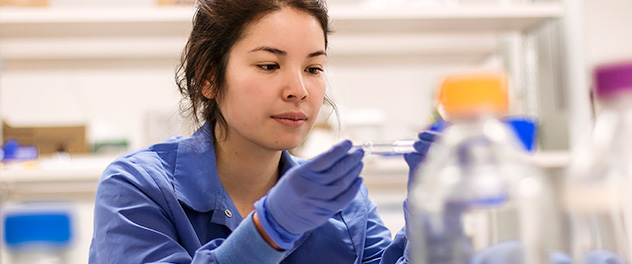 Attacking cancer from multiple angles
Attacking cancer from multiple angles
Dr. Quinones-Hinojosa's lab has research platforms on novel therapeutics for glioblastoma, cell migration and invasion, cellular therapy, and models of brain and spine cancers, and maintains a human tissue bank.
Research Platforms
Several avenues of investigation are being explored in Dr. Quinones-Hinojosa's Brain Tumor Stem Cell Research Laboratory at Mayo Clinic.
Novel therapeutics for glioblastoma
New projects related to aggressive brain cancers include research on nanodrug treatments and magnetic resonance-guided focused ultrasound for systemic therapy.
- Nanodrug cancer treatments. Dr. Quinones-Hinojosa's lab at Mayo Clinic has developed a self-assembling nanofiber hydrogel system for local therapy of glioblastoma and is investigating options for a local route of administration.
- Melatonin to enhance cancer treatments. Researchers in the Brain Tumor Stem Cell Research Lab are investigating the oncostatic effects of melatonin on glioblastoma to improve treatment and provide better quality of life for patients.
Cell migration and invasion
Projects in the Brain Tumor Stem Cell Research Lab investigate the effect of ion transporters in brain tumor cell migration and the molecular engines that drive tumor invasion.
- Ion transporters in cell migration. Dr. Quinones-Hinojosa's lab is studying how the NKCC1 protein maneuvers the cell during migration and using findings to develop new molecular targets for targeted cancer therapy.
- Molecular engines of tumor invasion. The Brain Tumor Stem Cell Research Lab studies genetic controls and mediators of tumor growth, invasion, and migration to understand how tumors move into the healthy brain.
Cellular therapy
Dr. Quinones-Hinojosa's lab is studying ways to engineer human fat cells to turn them into cancer-fighting Trojan horses and evaluating a gel to locally administer to patients during brain cancer surgery.
- Using fat to fight cancer. The Brain Tumor Stem Cell Research Lab at Mayo Clinic engineers human mesenchymal stem cells with nanotechnology to serve as Trojan horses for the treatment of cancer.
- Surgical stem cell gel. Dr. Quinones-Hinojosa's lab is evaluating the efficacy of a gel for administering human fat-derived mesenchymal stem cells within the brain cancer resection cavity during surgery.
Models of brain and spine cancer
The lab is creating models to better understand cancer migration and progression, to study invasive cell populations, and to uncover novel therapeutic targets to impact tumor progression.
- Chordoma of the spine. Dr. Quinones-Hinojosa's lab at Mayo Clinic is advancing pathophysiology research and driving new therapeutic strategies with the first orthotopic animal model of human chordoma.